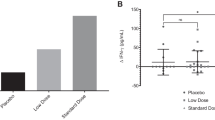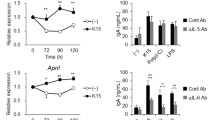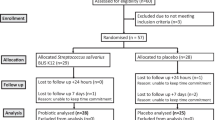Abstract
The effect of a daily intake of the probiotic strain Lactobacillus casei Shirota (LcS) on the colonisation of pathogens, specifically streptococci and Staphylococcus aureus, in the nose and throat of healthy human volunteers with low natural killer cell activity, was investigated in a randomised and controlled intervention study. The study consisted of a 2-week run-in phase, followed by a 4-week intervention phase. The probiotic treatment group received a fermented milk drink with LcS, while the placebo group received an equally composed milk drink without the probiotic additive. To isolate potential pathogenic streptococci and Staph. aureus, samples from the pharynx, as well as of both middle nasal meati, were taken, once after the run-in phase and once at the end of the intervention phase. Isolated bacteria were identified as either Staph. aureus and α- or β-haemolytic streptococci in a polyphasic taxonomical approach based on phenotypic tests, amplified ribosomal DNA restriction analysis genotyping, and 16S rRNA gene sequencing of representative strains. Salivary secretory immunoglobulin A (SIgA) was used as marker of protective mucosal immunity to evaluate whether LcS treatment influenced SIgA production. No statistically significant effect could be determined for intervention with LcS on the incidence of Staph. aureus in the nasal space, Staph. aureus in the pharyngeal space or for β-haemolytic streptococci and Streptococcus pneumoniae in the pharyngeal space. Thus, the intervention did not influence the nasopharyngeal colonisation with Gram-positive potential pathogens. Production of salivary SIgA as a potential means of microbiota modulation was also not affected.


Similar content being viewed by others
References
FAO/WHO (2002) Guidelines for the evaluation of probiotics in food. Report of a joint FAO/WHO working group on drafting guidelines for the evaluation of probiotics in food, London, Ontario, Canada, 30. April 1. Mai 2002
Donnet-Hughes A, Rochat F, Serrant P, Aeschlimann JM, Schiffrin EJ (1999) Modulation of nonspecific mechanisms of defense by lactic acid bacteria: effective dose. J Dairy Sci 82(5):863–869
Nagao F, Nakayama M, Muto T, Okumura K (2000) Effects of a fermented milk drink containing Lactobacillus casei strain Shirota on the immune system in healthy human subjects. Biosci Biotechnol Biochem 64(12):2706–2708
Gill HS, Cross ML, Rutherfurd KJ, Gopal PK (2001) Dietary probiotic supplementation to enhance cellular immunity in the elderly. Br J Biomed Sci 58(2):94–96
Parra D, De Morentin BM, Cobo JM, Mateos A, Martinez JA (2004) Monocyte function in healthy middle-aged people receiving fermented milk containing Lactobacillus casei. J Nutr Health Aging 8(4):208–211
Parra MD, de Morentin BEM, Cobo JM, Mateos A, Martinez JA (2004) Daily ingestion of fermented milk containing Lactobacillus casei DN114001 improves innate-defense capacity in healthy middle-aged people. J Physiol Biochem 60(2):85–91
Olivares M, Diaz-Ropero MP, Gomez N, Lara-Villoslada F, Sierra S, Maldonado JA, Martin R, Rodriguez JM, Xaus J (2006) The consumption of two new probiotic strains, Lactobacillus gasseri CECT 5714 and Lactobacillus coryniformis CECT 5711, boosts the immune system of healthy humans. Int Microbiol 9(1):47–52
Dong H, Rowland I, Tuohy KM, Thomas LV, Yaqoob P (2010) Selective effects of Lactobacillus casei Shirota on T cell activation, natural killer cell activity and cytokine production. Clin Exp Immunol 161(2):378–388. doi:10.1111/j.1365-2249.2010.04173.x
Mane J, Pedrosa E, Loren V, Gassull MA, Espadaler J, Cune J, Audivert S, Bonachera MA, Cabre E (2011) A mixture of Lactobacillus plantarum CECT 7315 and CECT 7316 enhances systemic immunity in elderly subjects. A dose-response, double-blind, placebo-controlled, randomized pilot trial. Nutr Hosp 26(1):228–235
Ortiz-Andrellucchi A, Sanchez-Villegas A, Rodriguez-Gallego C, Lemes A, Molero T, Soria A, Pena-Quintana L, Santana M, Ramirez O, Garcia J, Cabrera F, Cobo J, Serra-Majem L (2008) Immunomodulatory effects of the intake of fermented milk with Lactobacillus casei DN114001 in lactating mothers and their children. Br J Nutr 100(4):834–845. doi:10.1017/S0007114508959183
Sierra S, Lara-Villoslada F, Sempere L, Olivares M, Boza J, Xaus J (2010) Intestinal and immunological effects of daily oral administration of Lactobacillus salivarius CECT5713 to healthy adults. Anaerobe 16(3):195–200. doi:10.1016/j.anaerobe.2010.02.001
Reale M, Boscolo P, Bellante V, Tarantelli C, Di Nicola M, Forcella L, Li Q, Morimoto K, Muraro R (2012) Daily intake of Lactobacillus casei Shirota increases natural killer cell activity in smokers. Br J Nutr 108(2):308–314. doi:10.1017/S0007114511005630
Hojsak I, Snovak N, Abdovic S, Szajewska H, Misak Z, Kolacek S (2010) Lactobacillus GG in the prevention of gastrointestinal and respiratory tract infections in children who attend day care centers: a randomized, double-blind, placebo-controlled trial. Clin Nutr 29(3):312–316. doi:10.1016/j.clnu.2009.09.008
Klaenhammer TR, Kullen MJ (1999) Selection and design of probiotics. Int J Food Microbiol 50(1–2):45–57
Ouwehand AC, Salminen S, Isolauri E (2002) Probiotics: an overview of beneficial effects. Antonie Van Leeuwenhoek 82(1–4):279–289
Ohland CL, MacNaughton WK (2010) Probiotic bacteria and intestinal epithelial barrier function. Am J Physiol Gastrointest Liver Physiol 298(6):G807–G819. doi:10.1152/ajpgi.00243.2009
Suzuki K, Fagarasan S (2008) How host-bacterial interactions lead to IgA synthesis in the gut. Trends Immunol 29(11):523–531. doi:10.1016/j.it.2008.08.001
Brandtzaeg P (2007) Do salivary antibodies reliably reflect both mucosal and systemic immunity? Ann N Y Acad Sci 1098:288–311. doi:10.1196/annals.1384.012
Cerutti A, Rescigno M (2008) The biology of intestinal immunoglobulin A responses. Immunity 28(6):740–750. doi:10.1016/j.immuni.2008.05.001
Black F, Einarsson K, Lidbeck A, Orrhage K, Nord CE (1991) Effect of lactic-acid producing bacteria on the human intestinal microflora during ampicillin treatment. Scand J Infect Dis 23(2):247–254. doi:10.3109/00365549109023408
Cadieux P, Burton J, Gardiner G, Braunstein I, Bruce AW, Kang CY, Reid G (2002) Lactobacillus strains and vaginal ecology. JAMA 287(15):1940–1941. doi:10.1001/jama.287.15.1940
Huang JS, Bousvaros A, Lee JW, Diaz A, Davidson EJ (2002) Efficacy of probiotic use in acute diarrhea in children—a meta-analysis. Dig Dis Sci 47(11):2625–2634. doi:10.1023/A:1020501202369
Johnson BC, Supina AL, Ospina M, Vohra S (2007) Probiotics for the prevention of pediatric antibiotic-associated diarrhea. Cochrane Database Syst Rev 2. doi:10.1002/14651858.Cd004827.Pub2
Sazawal S, Hiremath G, Dhingra U, Malik P, Deb S, Black RE (2006) Efficacy of probiotics in prevention of acute diarrhoea: a meta-analysis of masked, randomised, placebo-controlled trials. Lancet Infect Dis 6(6):374–382. doi:10.1016/S1473-3099(06)70495-9
Guillemard E, Tondu F, Lacoin F, Schrezenmeir J (2010) Consumption of a fermented dairy product containing the probiotic Lactobacillus casei DN-114001 reduces the duration of respiratory infections in the elderly in a randomised controlled trial. Br J Nutr 103(1):58–68. doi:10.1017/S0007114509991395
Hatakka K, Savilahti E, Ponka A, Meurman JH, Poussa T, Nase L, Saxelin M, Korpela R (2001) Effect of long term consumption of probiotic milk on infections in children attending day care centres: double blind, randomised trial. Br Med J 322(7298):1327–1329. doi:10.1136/bmj.322.7298.1327
Maldonado J, Canabate F, Sempere L, Vela F, Sanchez AR, Narbona E, Lopez-Huertas E, Geerlings A, Valero AD, Olivares M, Lara-Villoslada F (2012) Human milk probiotic Lactobacillus fermentum CECT5716 reduces the incidence of gastrointestinal and upper respiratory tract infections in infants. J Pediatr Gastroenterol Nutr 54(1):55–61. doi:10.1097/Mpg.0b013e3182333f18
Morrow LE, Kollef MH, Casale TB (2010) Probiotic prophylaxis of ventilator-associated pneumonia a blinded, randomized, controlled trial. Am J Respir Crit Care 182(8):1058–1064. doi:10.1164/rccm.200912-1853OC
Siempos II, Ntaidou TK, Falagas ME (2010) Impact of the administration of probiotics on the incidence of ventilator-associated pneumonia: a meta-analysis of randomized controlled trials. Crit Care Med 38(3):954–962. doi:10.1097/Ccm.0b013e3181c8fe4b
Seifert S, Bub A, Franz CMAP, Watzl B (2011) Probiotic Lactobacillus casei Shirota supplementation does not modulate immunity in healthy men with reduced natural killer cell activity. J Nutr 141(5):978–984. doi:10.3945/jn.110.136440
Glück U, Gebbers JO (2003) Ingested probiotics reduce nasal colonization with pathogenic bacteria (Staphylococcus aureus, Streptococcus pneumoniae, and beta-hemolytic streptococci). Am J Clin Nutr 77(2):517–520
Pitcher DG, Saunders NA, Owen RJ (1989) Rapid extraction of bacterial genomic DNA with guanidium thiocyanate. Lett Appl Microbiol 8(4):151–156. doi:10.1111/j.1472-765X.1989.tb00262.x
Björkroth KJ, Korkeala HJ (1996) Evaluation of Lactobacillus sake contamination in vacuum-packaged sliced cooked meat products by ribotyping. J Food Prot 59(4):398–401
Sneath PHASR (1973) Numerical taxonomy: the principles and practise of numerical classification. Freeman, San Francisco
Papadimitriou K, Anastasiou R, Mavrogonatou E, Blom J, Papandreou NC, Hamodrakas SJ, Ferreira S, Renault P, Supply P, Pot B, Tsakalidou E (2014) Comparative genomics of the dairy isolate Streptococcus macedonicus ACA-DC 198 against related members of the Streptococcus bovis/Streptococcus equinus complex. BMC Genom 15:272. doi:10.1186/1471-2164-15-272
Hols P, Hancy F, Fontaine L, Grossiord B, Prozzi D, Leblond-Bourget N, Decaris B, Bolotin A, Delorme C, Dusko Ehrlich S, Guedon E, Monnet V, Renault P, Kleerebezem M (2005) New insights in the molecular biology and physiology of Streptococcus thermophilus revealed by comparative genomics. FEMS Microbiol Rev 29(3):435–463. doi:10.1016/j.femsre.2005.04.008
Kilian M (2002) Streptococcus and Enterococcus. In: Greenwood D, Slack RCB, Peutherer JF (eds) Medical microbiology. Churchill Livingstone, Edingburgh, pp 174–188
Huch M, De Bruyne K, Cleenwerck I, Bub A, Cho GS, Watzl B, Snauwaert I, Franz CM, Vandamme P (2013) Streptococcus rubneri sp. nov., isolated from the human throat. Int J Syst Evol Microbiol 63(Pt 11):4026–4032. doi:10.1099/ijs.0.048538-0
du Toit M, Huch M, Cho G-S, Franz CMAP (2014) The genus Streptococcus. In: Holzapfel WH, Wood BJB (eds) Lactic acid bacteria: biodiversity and taxonomy. Wiley, Chichester, pp 457–505. doi:10.1002/9781118655252.ch28
Gaillot O, Wetsch M, Fortineau N, Berche P (2000) Evaluation of CHROMagar Staph, aureus, a new chromogenic medium, for isolation and presumptive identification of Staphylococcus aureus from human clinical specimens. J Clin Microbiol 38(4):1587–1591
Flayhart D, Lema C, Borek A, Carroll KC (2004) Comparison of the BBL CHROMagar Staph aureus agar medium to conventional media for detection of Staphylococcus aureus in respiratory samples. J Clin Microbiol 42(8):3566–3569. doi:10.1128/jcm.42.8.3566-3569.2004
Han ZL, Lautenbach E, Fishman N, Nachamkin I (2007) Evaluation of mannitol salt agar, CHROMagar Staph aureus and CHROMagar MRSA for detection of meticillin-resistant Staphylococcus aureus from nasal swab specimens. J Med Microbiol 56(1):43–46. doi:10.1099/jmm.0.46777-0
Shittu A, Lin J, Morrison D, Kolawole D (2006) Identification and molecular characterization of mannitol salt positive, coagulase-negative staphylococci from nasal samples of medical personnel and students. J Med Microbiol 55(3):317–324. doi:10.1099/jmm.0.46072-0
Lowy FD (1998) Medical progress—Staphylococcus aureus infections. N Engl J Med 339(8):520–532. doi:10.1056/Nejm199808203390806
Pulverer G (1993) Carriers of staphylococci causing nosocomial infections. Zbl Hyg Umweltmed 194(1–2):144–151
Kluytmans JAJW, Wertheim HFL (2005) Nasal carriage of Staphylococcus aureus and prevention of nosocomial infections. Infection 33(1):3–8. doi:10.1007/s15010-005-4012-9
Nilsson P, Ripa T (2006) Staphylococcus aureus throat colonization is more frequent than colonization in the anterior nares. J Clin Microbiol 44(9):3334–3339. doi:10.1128/Jcm.00880-06
Bridges-Webb C, Gulasekharam J, Graydon JJ (1971) A bacteriological study of the upper respiratory tract in normal families. Med J Aust 1(14):735–738
Feery BJ, Forsell P, Gulasekharam M (1976) Streptococcal sore throat in general practice—a controlled study. Med J Aust 1(26):989–991
Levy RM, Leyden JJ, Margolis DJ (2005) Colonisation rates of Streptococcus pyogenes and Staphylococcus aureus in the oropharynx of a young adult population. Clin Microbiol Infect 11(2):153–155. doi:10.1111/j.1469-0691.2004.01042.x
Morita JY, Kahn E, Thompson T, Laclaire L, Beall B, Gherardi G, O’Brien KL, Schwartz B (2000) Impact of azithromycin on oropharyngeal carriage of group A Streptococcus and nasopharyngeal carriage of macrolide-resistant Streptococcus pneumoniae. Pediatr Infect Dis J 19(1):41–46
Gunnarsson RK, Holm SE, Soderstrom M (1998) The prevalence of potential pathogenic bacteria in nasopharyngeal samples from healthy children and adults. Scand J Prim Health Care 16(1):13–17
Begovac J, Bobinac E, Benic B, Desnica B, Maretic T, Basnec A, Kuzmanovic N (1993) Asymptomatic pharyngeal carriage of beta-hemolytic streptococci and streptococcal pharyngitis among patients at an urban hospital in croatia. Eur J Epidemiol 9(4):405–410. doi:10.1007/Bf00157398
Zwart S, Ruijs GJHM, Sachs APE, Van Leeuwen WJ, Gubbels JW, De Melker RA (2000) Beta-haemolytic streptococci isolated from acute sore-throat patients: cause or coincidence? A case-control study in general practice. Scand J Infect Dis 32(4):377–384
Murray PR, Baron EJ, Pfaller MA, Tenover FC, Yolken RH, American Society for Microbiology (1999) Manual of clinical microbiology, 7th edn. ASM Press, Washington, DC
Villena J, Chiba E, Tomosada Y, Salva S, Marranzino G, Kitazawa H, Alvarez S (2012) Orally administered Lactobacillus rhamnosus modulates the respiratory immune response triggered by the viral pathogen-associated molecular pattern poly(I:C). BMC Immunol 13:53. doi:10.1186/1471-2172-13-53
Villena J, Barbieri N, Salva S, Herrera M, Alvarez S (2009) Enhanced immune response to pneumococcal infection in malnourished mice nasally treated with heat-killed Lactobacillus casei. Microbiol Immunol 53(11):636–646. doi:10.1111/j.1348-0421.2009.00171.x
Souza-Fonseca-Guimaraes F, Adib-Conquy M, Cavaillon JM (2012) Natural killer (NK) cells in antibacterial innate immunity: angels or devils? Mol Med 18:270–285. doi:10.2119/molmed.2011.00201
Acknowledgments
This work was supported in part by Yakult Honsha Co., Ltd., Tokyo, Japan. The authors thank M. Brossart, E. Hoch, U. Stadler-Prayle, L. Uhlmann, and I. Specht for their excellent technical assistance.
Conflict of interest
Stephanie Seifert was supported in part by a grant of Yakult Honsha Co., Ltd., Tokyo, Japan. Melanie Huch, Jeannette Kramlich, Achim Bub, Gyu-Sung Cho, Bernhard Watzl, and Charles M.A.P. Franz declare that they have no conflict of interest.
Author information
Authors and Affiliations
Corresponding author
Rights and permissions
About this article
Cite this article
Franz, C.M.A.P., Huch, M., Seifert, S. et al. Influence of a probiotic Lactobacillus casei strain on the colonisation with potential pathogenic streptococci and Staphylococcus aureus in the nasopharyngeal space of healthy men with a low baseline NK cell activity. Med Microbiol Immunol 204, 527–538 (2015). https://doi.org/10.1007/s00430-014-0366-x
Received:
Accepted:
Published:
Issue Date:
DOI: https://doi.org/10.1007/s00430-014-0366-x




